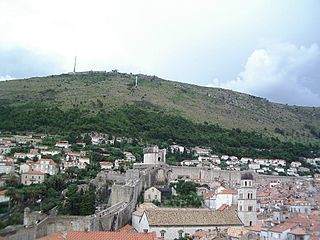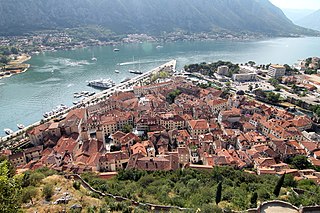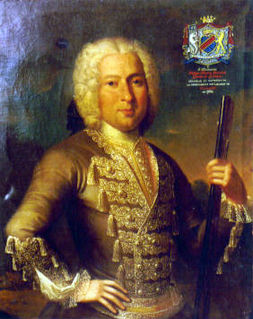
Dubrovnik, historically known as Ragusa, is a city on the Adriatic Sea in the region of Dalmatia, in southern Croatia. It is one of the most prominent tourist destinations in the Mediterranean Sea, a seaport and the centre of Dubrovnik-Neretva County. Situated in an exclave, it is connected to the rest of the country by the Pelješac Bridge. Its total population is 42,615. In 1979, the city of Dubrovnik was added to the UNESCO list of World Heritage Sites in recognition of its outstanding medieval architecture and fortified old town.

Kotor is a coastal town in Montenegro. It is located in a secluded part of the Bay of Kotor. The city has a population of 13,510 and is the administrative center of Kotor Municipality.

Prevlaka is a small peninsula in southern Croatia, near the border with Montenegro, at the entrance to the Bay of Kotor on the eastern Adriatic coast.

The Illyrian Provinces were an autonomous province of France during the First French Empire that existed under Napoleonic Rule from 1809 to 1814. The province encompassed modern-day Slovenia, Gorizia, Trieste, and parts of Croatia and Austria. Its capital was Ljubljana in Slovenia. It encompassed six départements, making it a relatively large portion of territorial France at the time. Parts of Croatia were split up into Civil Croatia and Military Croatia, the former served as a residential space for French immigrants and Croatian inhabitants and the latter as a military base to check the Ottoman Empire.

The Kingdom of Dalmatia was a crown land of the Austrian Empire (1815–1867) and the Cisleithanian half of Austria-Hungary (1867–1918). It encompassed the entirety of the region of Dalmatia, with its capital at Zadar.
The History of Dalmatia concerns the history of the area that covers eastern coast of the Adriatic Sea and its inland regions, from the 2nd century BC up to the present day.
Francesco Maria Appendini was an Italian Latin and Italian scholar who studied Slavic languages in the Republic of Ragusa. The French invasion prevented him from returning to Italy, and he adopted Republic of Ragusa as his own country. He took it upon himself to investigate its history and antiquities.

The Republic of Ragusa was an aristocratic maritime republic centered on the city of Dubrovnik in Dalmatia that carried that name from 1358 until 1808. It reached its commercial peak in the 15th and the 16th centuries, before being conquered by Napoleon's French Empire and formally annexed by the Napoleonic Kingdom of Italy in 1808. It had a population of about 30,000 people, of whom 5,000 lived within the city walls. Its motto was "Non bene pro toto libertas venditur auro", which means "Liberty is not sold for all the gold in the world".

The Croatian Dominican Province of the Annunciation of the Blessed Virgin Mary is a province of the Dominican Order, established in 1962 with a merger of Dalmatian Province, consisting of convents along Dalmatian coast and islands, and Congregation of Dubrovnik and convents in Gruž, with a house established in Zagreb in 1927. Today province consist of 13 convents and houses located in Croatia ten (10) convents and houses, Slovenia two (2) houses, and in Bosnia and Herzegovina one (1) house.

The Adriatic campaign was a minor theatre of war during the Napoleonic Wars in which a succession of small British Royal Navy and Austrian Navy squadrons and independent cruisers harried the combined naval forces of the First French Empire, the Kingdom of Italy, the Illyrian Provinces and the Kingdom of Naples between 1807 and 1814 in the Adriatic Sea. Italy, Naples and Illyria were all controlled either directly or via proxy by the French Emperor Napoleon I, who had seized them at the Treaty of Pressburg in the aftermath of the War of the Third Coalition.
The Kaboga were a patrician family from the city of Dubrovnik and its Republic of Ragusa. Their numbers, economic power and social and political status marked them as wealthy, influential and noble. Originating in the eighth century, they are one of the oldest and best-known families in Dubrovnik. Many of its members were rector (knez) of the republic, and the Austrian Empire recognized its members in 1818 and 1833 as counts.

The fortifications of Kotor are an integrated historical fortification system that protected the medieval town of Kotor containing ramparts, towers, citadels, gates, bastions, forts, cisterns, a castle, and ancillary buildings and structures. They incorporate military architecture of Illyria, Byzantium, Venice, and Austria. Together with the old town and its natural surroundings the fortifications were inscribed in the list of World Heritage Sites in 1979 labelled Natural and Culturo-Historical Region of Kotor and represent the only such site of cultural significance in Montenegro.

The Walls of Dubrovnik are a series of defensive stone walls surrounding the city of Dubrovnik in southern Croatia. With numerous additions and modifications throughout their history, they have been considered to be amongst the great fortification systems of the Middle Ages, as they were never breached by a hostile army during this time period. In 1979, the old city of Dubrovnik, which includes a substantial portion of the old walls of Dubrovnik, joined the UNESCO list of World Heritage Sites.

Bona, or Bunić, is a noble family long established in the city of Dubrovnik.

The Giorgi or Zorzi were a noble family of the Republic of Venice and the Republic of Ragusa.

Joseph Hélie Désiré Perruquet de Montrichard was a French general of the French Revolutionary Wars and Napoleonic Wars. His name is inscribed on the north side of the Arc de Triomphe. Montrichard commanded the right wing at the Battle of Trebbia in June 1799. In his final action, he surrendered Dubrovnik to an Anglo Austrian force under William Hoste in January 1814.

Srđ is a low mountain just behind the walled city of Dubrovnik in Dalmatia, Croatia. The mountain, part of the Dinaric Alps, has a height of 412 metres (1,352 ft). At its top is a large white stone cross and Fort Imperial, a defensive structure built by the French in 1810 during the Napoleonic Wars. Srđ is popular with tourists as a viewpoint from which it is possible to see the walled city of Dubrovnik, Lokrum island, the Adriatic Sea and various local attractions.

The siege of Cattaro was fought between a British Royal Naval detachment and Montenegrin forces under Captain William Hoste, John Harper and Petar I Petrović-Njegoš respectively and the French garrison under command of Jean-Joseph Gauthier of the mountain fortress of Cattaro. The siege lasted from 14 October 1813 to 3 January 1814 during the Adriatic campaign of the Napoleonic Wars when the French surrendered. The engagement was fought in the Adriatic Sea for possession of the important fortress of Cattaro.

Biagio Bernardo Caboga (1779-1854) was a Ragusan count (conte) and commander. He participated in the Ragusan uprising against the French, who had occupied since 1806, in 1813–14. With British support, he led the uprising after October 1813. Together with Austrian general Milutinović and British cannons, the Ragusan rebel leaders led the siege of the city in January 1814. The French surrendered on the 27th, marching out of the city on 28 January. Ragusa and its territories were handed over to the Habsburg monarchy in 1815. Despite his intelligence and ability, being described as having Alcibiades' qualities, his ambition seemed to have been the main cause to the failure of the aims of the rebellion.



















